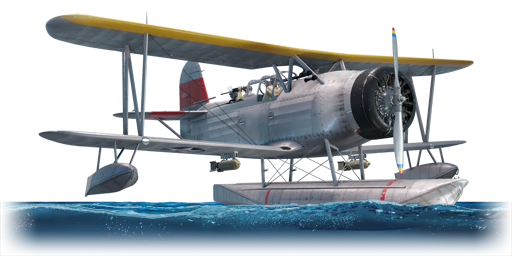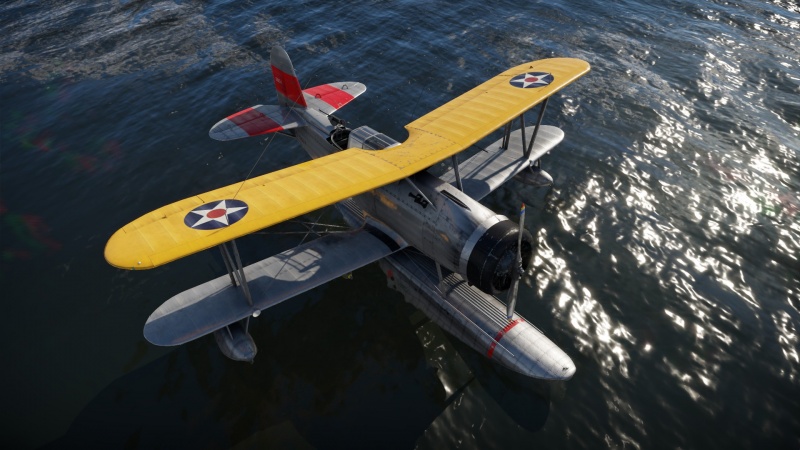SOC-1
Contents
Description
The SOC-1 Seagull is a gift rank I American bomber with a battle rating of 1.3 (AB/RB/SB). It was introduced in Update "Winged Lions" as a ship-launched reconnaissance aircraft.
Ships that carry the SOC-1
- USS Arizona
- USS Detroit
- USS Helena
- USS New Orleans
- USS Northampton
- USS Pensacola
- USS Portland
- USS Raleigh
General info
Flight performance
Describe how the aircraft behaves in the air. Speed, manoeuvrability, acceleration and allowable loads - these are the most important characteristics of the vehicle.
| Characteristics | Max Speed (km/h at _,___ m) |
Max altitude (metres) |
Turn time (seconds) |
Rate of climb (metres/second) |
Take-off run (metres) | |||
|---|---|---|---|---|---|---|---|---|
| AB | RB | AB | RB | AB | RB | |||
| Stock | ___ | ___ | 5950 | __._ | __._ | __._ | __._ | ___ |
| Upgraded | ___ | ___ | __._ | __._ | __._ | __._ | ||
Details
| Features | ||||
|---|---|---|---|---|
| Combat flaps | Take-off flaps | Landing flaps | Air brakes | Arrestor gear |
| _ | _ | _ | _ | _ |
| Limits | ||||||
|---|---|---|---|---|---|---|
| Wings (km/h) | Gear (km/h) | Flaps (km/h) | Max Static G | |||
| Combat | Take-off | Landing | + | - | ||
| 0 | 550 | ___ | ___ | ___ | ~__ | ~__ |
| Optimal velocities (km/h) | |||
|---|---|---|---|
| Ailerons | Rudder | Elevators | Radiator |
| < ___ | < ___ | < ___ | > ___ |
Survivability and armour
Examine the survivability of the aircraft. Note how vulnerable the structure is and how secure the pilot is, whether the fuel tanks are armoured, etc. Describe the armour, if there is any, and also mention the vulnerability of other critical aircraft systems.
Armaments
Offensive armament
The SOC-1 is armed with:
- 1 x 7.62 mm Browning machine gun, nose-mounted (500 rpg)
Suspended armament
The SOC-1 can be outfitted with the following ordnance:
- 2 x 100 lb AN-M30A1 bombs (200 lb total)
Defensive armament
The SOC-1 is defended by:
- 1 x 7.62 mm Browning machine gun, dorsal turret (500 rpg)
Usage in battles
Describe the tactics of playing in the aircraft, the features of using aircraft in a team and advice on tactics. Refrain from creating a "guide" - do not impose a single point of view, but instead, give the reader food for thought. Examine the most dangerous enemies and give recommendations on fighting them. If necessary, note the specifics of the game in different modes (AB, RB, SB).
Pros and cons
Summarise and briefly evaluate the vehicle in terms of its characteristics and combat effectiveness. Mark its pros and cons in the bulleted list. Try not to use more than 6 points for each of the characteristics. Avoid using categorical definitions such as "bad", "good" and the like - use substitutions with softer forms such as "inadequate" and "effective".
Pros:
Cons:
History
The Curtiss SOC-1 Seagull was an American single-engined scout observation seaplane, designed by Alexander Solla of the Curtiss-Wright Corporation for the United States Navy. The aircraft served on battleships and cruisers in a seaplane configuration, being launched by catapult and recovered from a sea landing. The wings folded back against the fuselage for storage aboard ship. When based ashore or on carriers the single float was replaced by fixed wheeled landing gear.
Development
The SOC was ordered for production by the United States Navy in 1933 and first entered service in 1935. The first order was for 135 SOC-1 models, which was followed by 40 SOC-2 models for landing operations and 83 SOC-3s. A variant of the SOC-3 was built by the Naval Aircraft Factory and was known as the SON-1.[1] The most numerous of the series, the SOC-1, internally designated the Curtis Model 71A, was powered by a 550hp (410 kW) Pratt & Whitney R-1340-18 Wasp single-row, nine-cylinder, air-cooled radial engine in an NACA cowling providing a top speed of 143 knots (165 mph) at 5,000ft. The plane had interchangeable floats or landing gear so it could operate on land or water. The armament of the SOC-1 was a single fixed .30 caliber AN/M2 Browning machine gun in a fixed-wing mount and a flexible model used by the observer. The Seagull could also carry 2 100lb bombs or 325lb depth charges on underwing mounts.[2]
Service History
The first ship the SOC was assigned to was the light cruiser USS Marblehead in November 1935; by the end of the decade, the SOC had replaced its predecessor throughout the fleet. Production came to an end in 1938. By 1941, most battleships had transitioned to the Vought OS2U Kingfisher and cruisers were expected to replace their aging SOCs with the third generation SO3C Seamew. The SO3C, however, suffered from a weak engine and plans to adopt it as a replacement were scrapped. The SOC, despite belonging to an earlier generation, went on to execute its missions of gunfire observation and limited range scouting missions.
Through the first six months of naval service, the SOC was known as the XO3C-1, The designation was changed to SOC when it was decided to merge its scouting and observation roles.[3] The SOC was not called the Seagull until 1941, when the U.S. Navy began the wholesale adoption of popular names for aircraft in addition to their alpha-numeric designations. The name 'Seagull' had earlier been given to two civil Curtiss aircraft, a Curtiss Model 18 and a Model 25, both converted Curtiss MF flying boats.[4]
When operating as a seaplane, returning SOCs would land on the relatively smooth ocean surface created on the sheltered side of the vessel as it made a wide turn, after which the aircraft would be winched back onto the deck.[5]
When the SOC was replaced by the OS2U Kingfisher, most remaining airframes were converted into trainers; they remained in use until 1945.[6] With the failure of the Curtiss SO3C Seamew, many SOCs in second line service were returned to frontline units starting in late 1943. They saw service aboard warships in the combat zone for the rest of World War II. This is one of the few instances in aviation history in which an older aircraft type, that was retired or sent to second line service, replaced the new aircraft type that was intended to replace it.[7]
In certain roles such as an observation aircraft for battleships, they served until 1949, and were eventually superseded by longer range radar and helicopters.[8]
References
- ↑ "US Navy History website". Archived from the original on 2014-12-16. Retrieved 2006-07-07.
- ↑ Green 1962, p. 160.
- ↑ Bowers 1979, pp. 339-340.
- ↑ Bowers 1979, pp. 178, 183, 627.
- ↑ World War II Database/SOC Seagull Archived 2016-06-29 at the Wayback Machine
- ↑ Munson 1985, p. 79.
- ↑ Donald 1997, p. ?.
- ↑ "Curtiss SOC Seagull". www.historyofwar.org. Retrieved 2023-12-18.
Media
Excellent additions to the article would be video guides, screenshots from the game, and photos.
See also
Links to the articles on the War Thunder Wiki that you think will be useful for the reader, for example:
- reference to the series of the aircraft;
- links to approximate analogues of other nations and research trees.
External links
Paste links to sources and external resources, such as:
- topic on the official game forum;
- other literature.
| Curtiss-Wright Corporation | |
|---|---|
| Fighters | BF2C-1 |
| P-36A · Rasmussen's P-36A · P-36C · P-36G | |
| P-40C · P-40E-1 · P-40F-10 | |
| Bombers | SB2C-1C · SB2C-4 |
| Floatplanes | SOC-1 |
| Experimental | XP-55 |
| Export | H-75A-1 · H-75A-4 · H-81A-2 · ▂P-40E-1 · ␗P-40E-1 · ▄P-40F-5 Lafayette · CW-21 · Hawk III |
| ▄SB2C-5 | |
| Captured | ▀Hawk H-75A-2 |
| Ship-launched reconnaissance aircraft | |
|---|---|
| USA | O3U-1 · OS2U-1* · SOC-1 |
| Germany | Ar 196 A-3* |
| USSR | KOR-1 |
| Britain | Osprey Mk IV · Walrus Mk.I |
| Japan | E7K2 · E8N2 · E13A1 · F1M2* |
| Italy | Ro.43 |
| France | GL.832HY · Loire 130С |
| *Available standalone in tech tree | |





